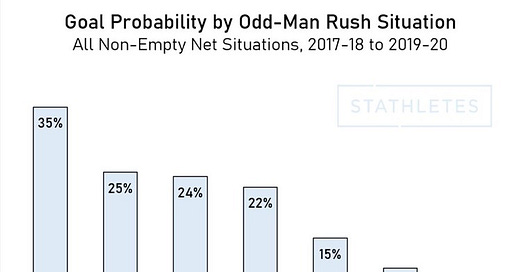One of the most dangerous plays in hockey is a 2v1 rush chance. According to Dom Galarmini of Stathletes, the probability of a 2v1 turning into a goal is 22%. These are dangerous situations that need to be converted.
Today we dive into 2v1 rushes from the offensive perspective to understand how to best maximize the effectiveness of the attacking team.
Puck carrier
On an odd-man rush, the puck carrier is the key decision-maker. They are the ones who choose to pass or shoot. Having their head up and reading the defender is of utmost importance.
Ideally, the puck carrier wants to do two things:
1) Work to and stay inside of the dots.
Puck carriers want to remain a dual-threat capable of releasing a shot or pass.
If they do not remain a shot threat, the goalie and defender can cheat to the pass option. Keeping defenders honest is key. Often in youth hockey, you’ll see players that skate themselves into the corner, killing their shooting angle and limiting their options.
2) Slow down
Slowing down allows players to create time to make the best decision as to whether to shoot or pass depending on what the defense offers.
Here is a great example of Patrick Kane working on slowing up on the rush while in a duel-threat position.
Passing Option
Non-puck carriers must prepare themselves in a ready position to catch a pass or one-time a shot on goal. This requires an open body position - front foot toe cap toward the end boards and loose back knee/skate. Thus, allowing for the largest possible range for a player to get them a useful puck. A common mistake in youth hockey and lower levels is skating to the back post on the backhand instead of “opening up” to the pass.
Sometimes players will even skate backward before opening their front skate. Sometimes players glide on the front foot awaiting the pass.


Deception
Once the basics are locked down, players can look to add wrinkles into the situation. “Looking off” what they really want to do is a great start.
Examples of faking a pass before shooting:


Examples of faking a shot before passing:


Early Pass
A recent trend that we heartily endorse is passing before the top of the circles with the goal of disrupting how a defender plays the rush. Often, this leads the defender into an earlier and more difficult decision, thus creating more space and options for the attacking team. As an added bonus (particularly at the lower levels) goalies that have to adjust their angle multiple times on the same rush are less apt to be square to the eventual shot).


Summary
Read the defense
Stay a duel-threat
Open & ready body positioning
Add deception + Pass early
Next, we look at the data behind playing 2v1s and how they can be applied to defending 2v1 rushes in hockey.
Further reading
Did you enjoy this newsletter?
Help us spread the ideas within and share it with the people you care about





